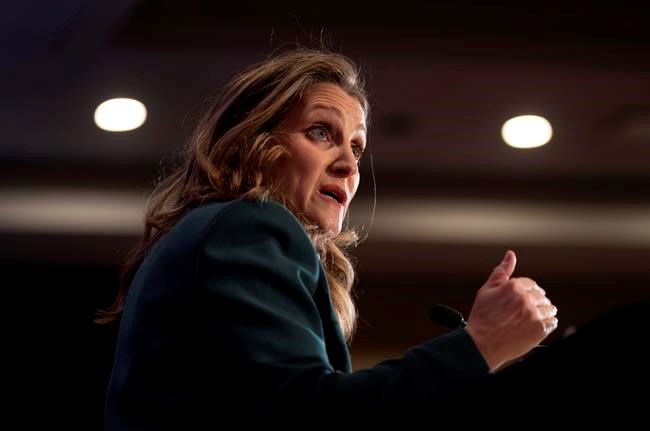OTTAWA — The federal government announced $59.5 billion of new spending over the next five years as part of a narrowly focused budget that also promises to find savings in the public service and increase tax revenues. Â
Finance Minister Chrystia Freeland’s budget, tabled in the House of Commons, has three main focuses: the clean economic transition, health care and cost-of-living relief.Â
To finance these priorities, the Liberals are promising to find $9.8 billion of savings within the public service. They also are introducing a range of tax measures, including ones aimed at wealthier individuals and corporations, that together would increase revenues by $11.7 billion.Â
At a time of high inflation and a slowing economy, Freeland had promised fiscal restraint and reiterated that commitment Tuesday.
"Our country has a proud tradition of fiscal responsibility. That is a tradition we are determined to uphold," Freeland said in a speech in the House of Commons while presenting the budget.
The federal deficit is projected to decrease to $14 billion by 2027-28 from $43 billion, while the debt-to-GDP ratio is expected to rise slightly in the coming year before falling to 39.9 per cent in 2027-28, down from 42.4 per cent.
Desjardins’ chief economist Jimmy Jean said the budget shows the federal government is trying to "strike a balance" to not fuel the flames of inflation. The host of affordability measures, which includes an additional boost to the GST rebate, are considered to be relatively modest.Â
"But at the same time … you’re not seeing the deficit close by the end of the projection (period)," Jean said.
Canada's debt-to-GDP ratio is expected to rise in 2023-24 to 43.5 per cent, then decline to 39.9 per cent in 2027-28. The federal government’s fiscal decisions are supposed to be guided by its fiscal anchor, which is a declining debt-to-GDP ratio in the medium term.
Rebekah Young, director of fiscal and provincial economics at Scotiabank, said she didn't find the budget to be fiscally restrained. Given the uncertainty in the economic outlook, Young said the federal government could have limited spending to "the bare bones."
On affordability, Young said the measures don't addressing housing, which poses as a major cost-of-living challenge that's not going to go away when inflation eases, and that some of the money could have been better spent elsewhere.
"There are areas where they could use some of this funding to increase the supply of social housing or the public provision of actual housing," Young said, adding that this approach would have gone further than simply addressing short-term inflation pressures.Â
To alleviate the pressure of rising grocery prices, the federal government has extended the GST rebate boost offered in the fall. The rebate, which will go to lower income Canadians, will deliver up to $234 to a single person and up to $467 to a couple with two children.Â
As the Canadian economy slows, the fiscal and economic projections in the budget have been downgraded from the fall fiscal update to account for a shallow recession this year.Â
While the Liberals' budget presents a more restrained approach to finances, the projected deficit is at risk of growing if the promised savings aren’t found and the economy slows more than expected. A sharper downturn would mean less tax revenues to finance the government’s priorities.Â
Jean said the likelihood of a deeper recession has increased amid high interest rates.
"You've got to question what (the Liberals) are going do if there’s a recession that’s deeper than expected," Jean said.Â
The Bank of Canada has aggressively raised its key interest rate over the last year, bringing it to 4.5 per cent, the highest it’s been since 2007.
High interest rates are already slowing the economy, which posted zero growth in the fourth quarter.
The economic projections in the budget, which are based on a survey of private sector economists, suggest real GDP will grow by 0.3 per cent this year. The government’s downside scenario, which offers a more pessimistic outlook, estimates a contraction of 0.2 per cent.
As the economy slows, the budget projects the unemployment rate will peak at 6.3 per cent by the end of the year. The unemployment rate in February, the most recent month with available data, was five per cent.
The economic projection also finds inflation is expected to fall below three per cent in the third quarter before returning to the Bank of Canada’s two per cent target in 2024.
Jean said the budget also hinges on the federal government following through with public service cuts, an exercise that’s considered challenging. On the tax front, Jean said there’s questions regarding how much the federal government will successfully raise from high-income earners.Â
"Those are very sophisticated individuals that can find ways to reduce or optimize their taxes," Jean said.
This report by The Canadian Press was first published March 28, 2023.
Nojoud Al Mallees, The Canadian Press




